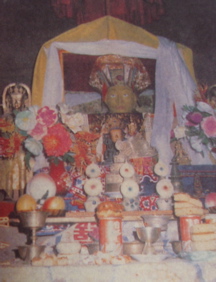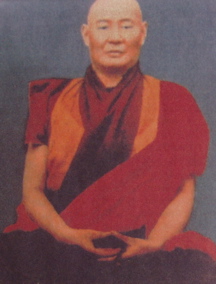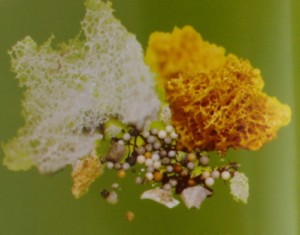The following is a translation of an article that appeared in the Asian Journal:

The Vajra Sharira or Relic of Kongkar Rinpoche after he shrunk to a little over one foot five inches in height.
Shariras are holy objects in Buddhism. The word sharira comes from Sanskrit and is translated as body, body bone, or bone relic. After the Buddha entered nirvana at death, his body was cremated. From that cremation appeared many holy objects as firm as diamonds. Buddhists call such things shariras.
Shariras are a type of crystal. They are as solid as steel and come in different shapes and numerous colors. It is recorded in Buddhist scriptures that after Shakyamuni Buddha entered nirvana at death, King Asoka, who was a king of the country Magadha in ancient India, built 84,000 stupas (memorial monuments) in which the shariras of Shakyamuni Buddha were buried. For example, the Bao Guang Temple in Xindu, China is one of the places where a stupa was built to contain the shariras distributed by King Asoka. There were nineteen such jeweled stupas built in China.
It is recorded in historical records that Huang Chao led an army of insurgents that captured the city of Changan. Emperor Xi Zong of the Tang Dynasty fled in haste to Chengdu. Emperor Xi Zong stayed in the Bao Guang Temple in the northern part of the city in the Xindu district of Chengdu. One year passed, and then another year passed. Because he could not return to the nation’s capital, he became depressed.
One evening when he was taking a walk in the temple, he suddenly saw a purple light emanate from the ruins of an ancient stupa. Xi Zong was amazed at this and asked Wu Da, the national teacher who followed the emperor, the meaning of that incident. Wu Da answered, “Those were shariras emanating light. It was an auspicious omen. The insurrection of Huang Chao has been quelled. Your majesty can now return to Changan.”
Xi Zong was elated and ordered people to dig into those ruins. It was discovered that there was a small stone box in the ground that indeed contained thirteen brilliantly glittering shariras of the Buddha. Xi Zong then ordered Wu Da to build a thirteen-story jeweled stupa and store the shariras in the stupa. Xi Zong named that stupa “Immaculate Pure Light Jeweled Stupa.” The Buddhist temple is still called Bao Guang (Treasure-Light) Temple. This incident of shariras emanating light was recorded in historical documents.
The different types of shariras are as follows:
1. VAJRA SHARIRAS also known as “human-body shariras”: In this case, after eminent monastics pass away, their bodies do not rot and may shrink. Thus, their bodies become firm Vajra shariras that do not decay. This is called “firm relics.” For example, the after-death bodies of the sixth patriarch of Zen, Master Hui Neng, as well as Master Han Shan, did not decay. Another example is that of Gong Ga (Kongkar) Rinpoche, who was six feet 2.3 inches tall before he passed away. After he passed away, his body shrank to one foot 5.3 inches, thus becoming a “human-body sharira.” There are also the examples of Dharma King Zongsa Khyentse and Master Pabongka, whose corpses shrank and became Vajra shariras. From flesh to bones, their entire bodies are as firm as a diamond. In 2011 the body of H.H. Dharma King Lama Achuk shrunk from almost sx feet in height to about 1 inch, a sign of his very high level of realization.
2. TRANSFORMATION BODY SHARIRAS (Nirmanakaya): This refers to shariras or sharira flowers left behind after those who have attained enlightenment are cremated. In general, these shariras come from the bodies of eminent monastics and lay men and women who have attained enlightenment. These shariras come in round, rhombus, and irregular shapes. Sharira flowers are divided into five types. For example, there is the type in the shape of a net. Its meshes are like that of a Vajra net. Its beauty surpasses that of any worldly object. The skull of Master Hsuan-tsang transformed into sharira flowers. The colors of sharira flowers originating in the bodies of those who have achieved the highest states of realization are peacock green, yellow stone color, or white jade color.
3. DHARMA BODY SHARIRAS (Dharmakaya): All of the sutras, skills, realization, Dharma powers, manifestations of supernatural states, and openings of holy wisdom handed down by the Buddha are Dharma body (Dharmakaya) shariras.
4. BONE SHARIRAS: This refers to the bones, skull, teeth, and other firm objects that appear after an average cremation, and do not have the structure of a net with open meshes.
5. SEED SYLLABLE SHARIRAS : When accomplished practitioners of the vajrayana cultivate themselves to the highest degree, they naturally cremate their own body, which then turns into a flash of light. The only things they leave behind is the seed syllables that they visualized in their normal visualization practice. Shariras in the form of such seed syllables are called seed syllable shariras. This process is also known as the body transforming into a rainbow light. Guru Padmasambhava’s body transformed into such a rainbow light.
Shariras have many different colors. Black shariras are the hair shariras left behind by a buddha. Red shariras are shariras resulting from the transformation of blood. White shariras come from bones. There are also shariras that are peacock green, golden-yellow, yellow, light yellow, dark brown, gray, purple, translucent, spotted, etc. Each type formed on the basis of the person’s level of realization. Different colors and sizes reflect different levels of realization. Anyone who leaves behind transformation body shariras must have attained enlightenment.
What the buddhas leave behind are called shariras. What the bodhisattvas leave behind are called firm relics. Both types result from constantly accumulating great and pure compassion as well as the perfection of one’s realization and merit. Most people confuse shariras with firm relics. They also label firm relics as shariras.
Shariras do not bully the weak, nor do they fear the strong. Shariras safeguard living beings. They sacrifice themselves to benefit others. When you put a sharira on an iron anvil and hammer it, it will bore itself into the anvil, and nobody will be able to get it out. If a steel bore is used to get it out, no matter how deep that steel bore goes into the anvil, the sharira will bore itself even deeper into the anvil. To the sharira, the anvil is like mud. No matter how a steel bore bores into the anvil, it will never be able to take out the sharira. This is an example of shariras not fearing the strong.
However, if you put a chicken egg on the anvil over the place the sharira has bored into, and if it appears from your posture that you are about to crush that egg, the sharira that bored into the anvil will on its own immediately jump out. That is because the sharira is compassionate and fears that the chicken egg will be harmed. This is an example of shariras not bullying the weak.
Shariras have five characteristics. First, they are different based upon one’s merit. They will manifest different colors and different levels of brightness or darkness according to one’s karma and merit. The second characteristic is that of firmness or solidity. Shariras are indestructible. They are harder than any object in the world. The third characteristic is brightness. When viewing shariras, one sees their luster and become happy. When worshipping them, if your heart is powerful enough to evoke a response, they will emanate brilliant light. Fourth, shariras can reproduce themselves. An example of this is the hair shariras of Kang Sa Rinpoche. Fifth is the characteristic of bringing good fortune. If you build a stupa to worship them, circumambulate them, prostrate before them, light lamps near them, offer flowers to them, light incense near them, make repairs to the stupa, gild the stupa, or ornament the stupa, you will receive tremendous good fortune.
What type of person produces shariras as a result of their cultivation? Only those who practice authentic Buddhism and have attained the realization of an accomplished (liberated) one have shariras or firm relics. Only those who have attained great accomplishment (liberation) based upon authentic Buddhism have sharira flowers. Those who do not practice authentic Buddhism will not have shariras, firm relics, or sharira flowers. Those who practice authentic Buddhism yet who have not attained great accomplishment will also not have shariras, firm relics, or sharira flowers.
(Written by Shang Miao)
Heart Shrine Relic Tour
Examples of relics of great saints incluidng Shakyamuni Buddha, Yeshe Tsogyel, Milarepa, Tsongkhapa, Marpa, and others.


